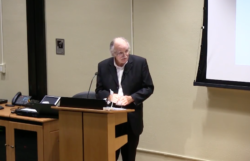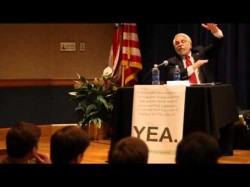The White House and Your House: Policy Inertia and Organizational Resistance in the On-going Crisis of American Housing
Ask any of the Republican presidential hopefuls in this long and drawn out primary season what in general is wrong with the economic policies of the Obama Administration, and they will each tell you that the economy is under-performing now because the current Administration intervenes in its workings too frequently and too heavily. They will each tell you that the private sector has not yet rebounded with sufficient vigor from the recession of 2008-9 because the footprint of the federal government is everywhere – everywhere too present and everywhere too controlling.
That standard Republican litany has one particularly unfortunate consequence – at least for potential Republican voters. It prevents any of the Party’s would-be presidential nominees from pointing to areas of American economic and social life in which current under-performance is caused by the lack of adequate federal intervention. Yet there are such areas, and they are areas of genuine Obama weakness. Two in particular spring to mind: inadequate intervention in the U.S. housing market,[1] and inadequate prosecution of banking folly and corruption.[2] Indeed the two are linked: the inability or unwillingness of the Obama Administration to adequately prosecute and control the economy’s major financial institutions is now one further cause of its inability to rapidly and effectively resolve the U.S. housing crisis.
And there still is a major U.S. housing crisis.
It is true that recently we have seen some small signs of recovery. Home re-sales in the U.S. were 0.7% higher in January 2012 than they were in January 2011,[3] and building permits in February 2012 were back to their October 2008 level.[4] But straws in the wind are just that – straws. In the contemporary U.S. housing market adverse winds continue to howl. House prices are still falling and the number of foreclosed homes is still going up – and in both cases by some margin. In February 2012, the Standard and Poors/Case Shiller index of property values for America’s top 20 cities showed national housing prices generally down from their 2009 level, 33% down from their 2006 level, possibly even at their lowest level since 2003.[5] Federal Reserve calculations were similar: that 33% drop in house prices since their peak in 2006 has resulted “in about $7 trillion in household wealth losses and an associated ratcheting down of aggregate consumption.”[6] Meanwhile new housing starts, once running at 2.37 million a year, have fallen to less than 700,000. ‘Eighty percent of a major industry,” to quote Case, “just disappeared.” [7] The only price currently going up in the contemporary U.S. housing market is the price of renting.[8] The average price (and indeed the average size) of new homes are not.[9]
The data on foreclosures – past, present and immediate future – is, if anything, grimmer still. Currently, “Moody Analytics estimates that 3.3 million homes are in or near foreclosure and another 11.5 million underwater homeowners are at risk of foreclosure if the economy or their finances weaken.”[10] That, in addition to the roughly four million houses that have already been foreclosed since early 2007.[11] To make matters worse, part of that impending foreclosure explosion is the product of the Obama Administration’s belated and modest attempts to penalize the banks for their mismanagement of the original foreclosure crisis. By recently settling with them for a modest $26 billion, the Obama Administration has freed the banks to unload the backlog of foreclosed properties onto which they were holding, pending the settlement. On the government’s own figures, there are currently 3.6 million vacant homes still being held off the market, homes that once released will likely be “priced at a deep discount.”[12]
—
It is not, however, that the Administration is indifferent to the housing crisis, or reluctant to intervene. On the contrary, the need for policy is widely recognized across the Administration. The notion that, as Mitt Romney put it, the housing market should simply be left alone to “bottom out,”[13] was explicitly rejected by Federal Reserve governor Elizabeth Duke in evidence before the Senate Banking committee in February. “Six years after aggregate house prices first began to decline, and more than two years after the start of the recovery,” she told the Senators, “the housing market remains a significant drag on the U.S. economy….the current recovery has not followed this script, in part because the problems in the housing market are a cause of the downturn as well as a consequence of it.”[14] Indeed in January 2012, the Federal Reserve took the unprecedented step of issuing a report on U.S. housing and its adverse effects on the wider economy, justifying its publication as part of the Fed’s general responsibility for economic recovery. The U.S. Housing Market: Current Conditions and Policy Recommendations proposed a series of measures to ease the housing crisis, and so remove a major barrier to sustained recovery and rapid job growth. In doing so, the Federal Reserve aligned itself, whether consciously or otherwise, with a string of liberal commentators (and with the President’s own Council of Economic Advisers[15]) who are similarly aware that, without a rapid recovery in the U.S. housing market, any general economic recovery will be slow and limited.[16]
Nor is it the case that the President himself is indifferent. He is not. We have plenty of evidence that “he has been dismayed by the failure of his programs to have even more of an impact, and disappointed by the results of federal investigations showing that banks routinely disregard the rights of homeowners facing foreclosure.”[17] As he said in Virginia last month: “I’ll be honest – the programs we put forward haven’t worked on the scale that we hoped.”[18] That perhaps helps explain why, in his latest State of the Union Address, the President was adamant that “while government can’t fix the problem on its own, responsible homeowners shouldn’t have to sit and wait for the housing market to hit rock bottom to get some relief.” His solution: new policy to allow them to “save about $3,000 a year on their mortgage by refinancing at historically low interest rates.” [19] Such presidential frustration also lay behind his insistence, when delivering the State of the Union Address, on “no more runaround from the banks. A small fee,” as he put it, “on the largest financial institutions will ensure that it won’t add to the deficit, and will give banks that were rescued by taxpayers a chance to repay a deficit of trust.” [20] More recently still (March 6th), Barack Obama chose to open his first press conference of 2012 with what he termed “a few announcements about some steps we’re taking to help responsible homeowners who’ve been struggling through the housing crisis.” Those steps included the State of the Union proposal, plus the halving of the refinancing fees families pay for loans insured by the FHA, plus strong protection from wrongful foreclosure by banks for serving members of the armed forces.[21]
—
So why, given all this Administration concern, are we still in a housing crisis of such proportions? We are still in that crisis partly because of the lateness, modesty and overall inadequacy of the Administration’s attempts to solve it. We are still in that crisis also in part because of the Administration’s inability (or unwillingness) to see even its modest policies fully enacted by the agencies and institutions central to their delivery. Indeed, initially the problem of delivery was one of White House unwillingness to pursue housing market intervention on an adequate scale; but now, with that willingness enhanced, the barriers seem to lie more in the inability of the Administration to see its policies effectively implemented.
The roots of the present policy failures are ultimately three.
- The Obama Administration’s policy towards the housing crisis was initially limited by moral hazard concerns; and has only slowly – and very incrementally – moved beyond those limits.[22] It is true that the President “has unveiled more than half a dozen plans in recent months to help millions more Americans refinance their mortgages at lower rates, to reduce the debts owed by struggling homeowners and to expand existing programs to broaden the pool of borrowers eligible for government aid.”[23] It is also true that, under Administration pressure, the FHA, Fannie Mae and Freddie Mac now allow mortgage lenders the leeway to grant unemployed borrowers deferral of part or all of their monthly mortgage payments for six months (or with official clearance, even for a year).[24] But it is also the case that Administration policy in this key area has invariably followed developments in the housing market – never getting ahead of the curve (the administration’s plans seem “targeted at the housing crisis as it existed six months ago, rather than as it exists now.” was how Elizabeth Warren earlier described it[25]) – such that even now policy is primarily focused on lowering the costs of refinancing for those homeowners still in their homes. Yet “letting borrowers refinance only if they’re current on payments won’t help people on the verge of losing their homes. And refinancing won’t reduce principal, so underwater borrowers stay underwater.”[26] The Administration now estimates that lowering FHA refinancing fees might aid 2-3 million householders; but estimates of this kind were made regularly on earlier initiatives, all of which then seriously under-performed. The Administration’s flagship HAMP[27] program, for example, was supposed to save 3-4 million struggling homeowners from foreclosure. By December 2011, it was on track to save less than one million.[28] Modest as it is, there seems no reason why this latest small initiative should not under-perform also.
- A more extensive and effective intervention in the housing market was initially blocked by Treasury concerns about tax burdens. It would appear now to be blocked by the unwillingness of the FHFA to do the President’s bidding. The head of the FHFA remains Edward DeMarco, a Bush appointee whom the Obama Administration has tried unsuccessfully to replace with its own nominee, Joseph Smith. If press reports are accurate, serious disagreements on policy exist between DeMarco and HUD Secretary Shaun Donovan. HUD has been encouraging more principal write-downs, to enable people to stay in their homes – even if those mortgages are backed by Fannie and Freddie. But Fannie and Freddie answer to the FHFA, not to HUD; and DeMarco opposes write-downs, claiming other policies to be more effective. “Of the four principal foreclosure fighting powers available to FHFA,” Mike Lillis has reported, “reducing interest rates, extending the length of loans, principal forbearance and principal forgiveness, the last, DeMarco said, is the least valuable to regulators trying to repay the taxpayers who bailed out Freddie and Fannie more than three years ago.”[29] It is also, apparently, in DeMarco’s view, a policy “that would not meet the FHFA’s responsibilities as conservator of Fannie and Freddie….a statutory responsibility,” as he told Congress, “to preserve and conserve the enterprises’ assets.”[30] Though now at last there are signs that things may be improving – signs literally this weekend that FHFA flexibility may be on the increase[31] – it is still hard to avoid the conclusion that, although the U.S. taxpayer owns the two main GSEs, ownership has not yet turned them into pliable policy instruments for a progressive administration. Indeed, and on the contrary, at the very moment that the Administration is pressing Fannie and Freddie to do more to help struggling homeowners, the FHFA is planning to scale the GSEs back, initially by increasing the fees they charge to borrowers.[32]
- This policy inertia is now being compounded by the Administration’s reluctance to put heavy pressure on the banks to switch their practices from foreclosure sales to home maintenance. The evidence of extensive malpractice by financial institutions through the length and breadth of the foreclosure crisis is now overwhelming.[33] The evidence is so overwhelming in fact that the major banks have made two sets of settlements of late, in an attempt to head off prosecution and civil damages. Bank of America made a series of settlements in 2011 with the GSEs and with a string of private investors; and America’s five leading U.S. banks made a settlement in February 2012 with the U.S. Government and with 49 states’ Attorney Generals (all but California). Both settlements obliged leading financial institutions to make modest recompense; but neither settlement obliged the largest banks to so absorb losses on the mortgages they mishandled as to prevent an avalanche of foreclosures. In 2008-9, major banks in trouble were bailed out by American homeowners as taxpayers; but in 2012 American homeowners in trouble are not being bailed out by those same banks to anything like the same degree. This asymmetry is the product of both bank intransigence and lack of Administration pressure. What the most recent settlement does is exchange bank immunity from government lawsuits for $26 billion of relief, including principal write-downs, relief that will reach an estimated 1.75 million borrowers. The terms of the settlement are hardly commensurate, however, with either the scale of the wrong-doing or its consequences: $26 billion is simply a drop in the bucket when compared either to the losses on household wealth created by the housing price meltdown ($7 trillion at least) or to the value of mortgages still caught up in the foreclosure process ($254 billion).[34] Yet worse: the banks are allowed three full years to implement the deal; and they are obliged to compensate those foreclosed against between 2008 and 2011 only with a meager $1500-$2000. Try buying a house with that!
We need constantly to remind ourselves that behind the housing numbers stand real people and real lives – real people who are suffering mightily, and real lives that are being blighted daily, by policy failure of this kind. The vast majority of Americans now caught up in the housing crisis are both innocent victims of recession and unemployment and citizens who vote. So for reasons of electoral calculation as well as of common humanity, the Obama Administration would do well to move quickly and publicly to do more.[35] At the very least, it should prioritize the conversion of foreclosed properties into rentals [36] It should prioritize too the rights of the existing mortgage holder to become that renter, until personal circumstances allow a return to home ownership. More radically, the Administration should press the banks to write off the bulk of the principal loss – the banks, after all, are back to huge profitability again[37] – and so end, once and for all, this nightmare of job-loss being followed by house-loss for core American middle class families. I, for one, agree with William Greider – and hope you might too.[38]
“There is a solution….It is forgiveness – forgive the debtors. Write down the principal they owe on their mortgage to match the current market value of their home, so that they will be no longer be underwater. Refinance the loan with a reduced interest rate, so the monthly payment is at a level that the struggling homeowner can handle. This keeps families in their homes, with a renewed stake in their future. It gives homeowners incentives to keep up their payments, because once again they have some equity and the opportunity to accumulate much more….Forgiving the debtors is the right thing to do, because the bankers have already been forgiven.”
[1] For Republican misunderstandings of the causes of the current housing crisis, see https://www.davidcoates.net/2012/01/29/republican-truth-and-real-truth-gses-and-the-housing-bubble/
[2] For Republican misunderstandings of the need for tighter bank regulation, see https://www.davidcoates.net/2012/02/23/taking-the-republicans-to-task-2-on-the-regulation-of-business-and-labor/
[3] Alan Zibel and Eric Morath, “Home Resales Climb Higher,” The Wall Street Journal, February 23, 2012: available at http://joanjwray.posterous.com/home-resales-climb-higher-wall-street-journal
[4] Neil Shah and Nick Timiraos, “Housing Shows Signs of Life,” The Wall Street Journal, March 21, 2012: available at http://thetucsonfoothills.typepad.com/
[5] Peter Whoriskey, “House prices hit post-bubble low,” The Washington Post, January 31, 2012: available at http://www.washingtonpost.com/business/economy/house-prices-hit-post-bubble-low/2012/01/31/gIQAYBTEgQ_story.html
[6] The U.S. Housing Market: Current Conditions and Policy Recommendations, p. 1: available at http://www.communityprogress.net/-the-u-s–housing-market–current-conditions-and-policy-considerations–resources-128.php
[7] Cited in Whoriskey, op.cit
[8] Matthew Yglesias, ‘Why the Rent is Too Damn High,” Slate, March 1, 2012: available at http://www.slate.com/blogs/moneybox/2012/03/06/the_rent_is_too_damn_high_available_today.html
[9] Sara Robinson, Kiss the McMansion Goodbye: Is the American Home Shrinking? Posted on Alternet.org, March 16 2012: available at http://www.alternet.org/visions/154582/kiss_the_mcmansion_goodbye%3A_is_the_american_home_shrinking/
[10] Editorial, “How Good Is the Housing News?”, The New York Times, March 7, 2012: available at http://www.nytimes.com/2012/03/08/opinion/how-good-is-the-housing-news.html
[11] Times Topics, “Foreclosures (2012 Robosigning and Mortgage service settlement), The New York Times, March 18, 2012: available at http://topics.nytimes.com/top/reference/timestopics/subjects/f/foreclosures/index.html
[12] Robert Cyran, U.S. housing hangover finally wearing off, Reuters, March 19, 2012: available at http://blogs.reuters.com/breakingviews/2012/03/19/u-s-housing-hangover-finally-wearing-off/
[13] Andrew Kaczynski, Romney Viewed Affordable Housing as Right, Not Privilege, Buzzfeed, January 13, 2012: available at http://www.buzzfeed.com/andrewkaczynski/romney-viewed-affordable-housing-as-right-not-pri
[14] Cited in Michael A. Fletcher, “Housing prices fell in December, continue to hurt economic recovery,” The Washington Post, February 28, 2012: available at http://www.washingtonpost.com/business/economy/housing-prices-fell-in-december-continue-to-hurt-economic-recovery/2012/02/28/gIQAwnK3gR_story.html
[15] Council of Economic Advisers, Economic Report of the President 2012, Washington DC: U.S. Government Printing Office, 2012, p. 110: available at http://www.gpo.gov/fdsys/granule/ERP-2012/ERP-2012-chapter4/content-detail.html
[16] Robert Reich, “Housing is the rotting core of the US recovery,” The Financial Times, February 27, 2012: available at http://www.ft.com/intl/cms/s/0/d10dd468-6136-11e1-a738-00144feabdc0.html#a
[17] Zachary A Goldfarb, ‘Obama unveils new foreclosure measures to resuscitate housing market,” The Washington Post, March 8, 2012: available at http://www.washingtonpost.com/business/economy/obama-unveils-new-foreclosure-measures-to-resuscitate-housing-market/2012/03/07/gIQAJLB3zR_story.html
[18] Remarks by the President on Housing, Falls Church, Virginia, February 1, 2012: available at http://www.whitehouse.gov/the-press-office/2012/02/01/remarks-president-housing
[19] State of the Union Address, January 31, 2012: available at http://www.whitehouse.gov/state-of-the-union-2012
[20] Ibid
[21] March 6, 2012 press conference at the White House: transcript available at http://www.whitehouse.gov/the-press-office/2012/03/06/press-conference-president
[22] See earlier commentary on this site for details:
https://www.davidcoates.net/2011/02/13/obama-and-housing-%E2%80%93-is-anybody-home/ : https://www.davidcoates.net/2010/08/01/the-foreclosure-crisis-that-will-not-go-away/ ; https://www.davidcoates.net/2010/05/07/the-foreclosure-crisis/ and
https://www.davidcoates.net/2010/01/30/the-housing-policy-in-2009/
[23] Goldfarb, op.cit
[24] Motoko Rich, “Unemployed Mortgage Holders Get Extension on Payments,” The New York Times, January 11, 2012: available at http://www.nytimes.com/2012/01/12/business/unemployed-mortgage-holders-get-payment-extension.html
[26] Jed Kolko, State of the Union: Small missing pieces in the Messy Housing Puzzle, posted on The Huffington Post, January 25, 2012: available at http://www.huffingtonpost.com/jed-kolko/state-of-the-union-housing-crisis_b_1230073.html
[27] Home Affordable Modification Program, details at http://www.makinghomeaffordable.gov/programs/lower-payments/Pages/hamp.aspx
[28] Council of Economic Advisers, Economic Report of the President 2012, Washington DC: U.S. Government Printing Office, 2012, p. 105: available at http://www.gpo.gov/fdsys/granule/ERP-2012/ERP-2012-chapter4/content-detail.html
[29] Mike Lillis, “Dems raise pressure on Fannie, Freddie regulator to write-down mortgages,” The Hill, March 4, 2012: available at http://thehill.com/homenews/house/213975-dems-raise-pressure-on-fannie-freddie-regulator-to-write-down-mortgage-principle-
[30] Richard (RJ) Eskow, Edward DeMarco: The Ideologue Who’s Holding Homeowners – and the Economy – Hostage, posted on The Huffington Post February 14, 2012: available at http://www.huffingtonpost.com/rj-eskow/edward-demarco-the-ideolo_b_1275360.html
[31] Chris Arnold, “Fannie, Freddie Consider Mortgage Write-Downs,” NPR, March 23, 2012: available at http://www.npr.org/2012/03/23/149166144/fannie-freddie-press-for-mortgage-write-downs
[32] Zachary A. Goldfarb, “FHFA release plan for Freddie, Fannie exit,” The Washington Post, February 21, 2012: available at http://www.washingtonpost.com/business/economy/fhfa-releases-plan-for-freddie-fannie-exit/2012/02/21/gIQAO8NTRR_story.html
[33] See Shahien Nasiripour, Big Banks Save Billions as Homeowners Suffer, Internal Federal Report by CFPB Finds, posted on The Huffington Post March 29, 2011: available at http://www.huffingtonpost.com/2011/03/28/big-banks-save-billions-homeowners-suffer_n_841712.html
[34] Gillian Tett, “US debt reduction has a long way to go,” The Financial Times, January 19, 2012: available at http://www.ft.com/intl/cms/s/0/7869b61c-42c6-11e1-93ea-00144feab49a.html#axzz1pql5GeQc
[35] See John Griffith, Time to Get Serious About the Housing Market, Center for American Progress, January 9, 2012: available at http://www.americanprogress.org/issues/2012/01/get_serious_about_housing_market.html
[36] The U.S. Housing Market: Current Conditions and Policy Recommendations, p. 11: available at http://www.communityprogress.net/-the-u-s–housing-market–current-conditions-and-policy-considerations–resources-128.php
[37] See Van Jones and George Goehl, Obama Must Choose on Housing: A Sweetheart Deal for the 1% or a Fair Deal for the 99%, posted on The Huffington Post January 23, 2012: available at http://www.huffingtonpost.com/van-jones/obama-housing_b_1221921.html
[38] William Greider, “Debt Jubilee, American Style,” The Nation, November 14, 2011: available at http://www.thenation.com/article/164216/its-time-debt-forgiveness-american-style
Tags: Bank of America, Edward DeMarco, Elizabeth Warren, Fannie Mae, Federal Reserve, FHFA, Freddie Mac, HAMP, Housing crisis. foreclosures, HUD, Obama administration, William Greider
David Coates holds the Worrell Chair in Anglo-American Studies at Wake Forest University. He is the author of Answering Back: Liberal Responses to Conservative Arguments, New York: Continuum Books, 2010.
He writes here in a personal capacity.






Barry Clendenin says:
David —
This is an excellent assessment of a complicated market with a number of moving parts. In my view and from recent discussions with others in the field, progress is being made but it could take about another decade for the housing market to unwind. Continuing to add greater transparency to housing transactions, especially the role of the GSEs should help in this effort.
Best regards.
Barry
David Coates: Poverty and Unemployment: The Unfinished Business of the Obama Administration | WestPenn Journal says:
[…] in which the Obama Administration has – to put it politely – so far under-performed. Housing policy is one. Holding bankers accountable is another. Extracting us from unnecessary wars is […]
Poverty and Unemployment: The Unfinished Business of the Obama Administration says:
[…] in which the Obama Administration has – to put it politely – so far under-performed. Housing policy is one. Holding bankers accountable is another. Extracting us from unnecessary wars is […]
David Coates: The Unfinished Business of the Obama Administration: The Foreclosure Crisis | Gyred News says:
[…] David Coates: The Unfinished Business of the Obama Administration: The Foreclosure Crisis July 10, 2012By staffAdministrations are invariably criticized for things they do right, for things they do wrong, and for things they fail to do at all. They are invariably criticized for doing too much and criticized for doing too little. Conservative critics of the current Administration tend to do the former. Liberal, by contrast, would do well to focus on the latter. For thus far, this Administration’s failures – in domestic policy at least – are more the product of doing too little too late, than of doing too much too soon. Nowhere is that failure clearer than in the Administration’s inept handling of the home foreclosure crisis. […]
The Unfinished Business of the Obama Administration: The Foreclosure Crisis « Lead MLS says:
[…] The Unfinished Business of the Obama Administration: The Foreclosure Crisis Administrations are invariably criticized for things they do right, for things they do wrong, and for things they fail to do at all. They are invariably criticized for doing too much and criticized for doing too little. Conservative critics of the current Administration tend to do the former. Liberal, by contrast, would do well to focus on the latter. For thus far, this Administration’s failures — in domestic policy at least — are more the product of doing too little too late, than of doing too much too soon. Nowhere is that failure clearer than in the Administration’s inept handling of the home foreclosure crisis. […]
The Unfinished Business of the Obama Administration: The Foreclosure Crisis | deterforeclosure.com says:
[…] Administrations are invariably criticized for things they do right, for things they do wrong, and for things they fail to do at all. They are invariably criticized for doing too much and criticized for doing too little. Conservative critics of the current Administration tend to do the former. Liberal, by contrast, would do well to focus on the latter. For thus far, this Administration’s failures — in domestic policy at least — are more the product of doing too little too late, than of doing too much too soon. Nowhere is that failure clearer than in the Administration’s inept handling of the home foreclosure crisis. […]
The Unfinished Business of the Obama Administration: The Foreclosure Crisis | The Niche Report says:
[…] The Unfinished Business of the Obama Administration: The Foreclosure Crisis (HuffingtonPost by David Coates) — Administrations are invariably criticized for things they do right, for things they do wrong, and for things they fail to do at all. They are invariably criticized for doing too much and criticized for doing too little. Conservative critics of the current Administration tend to do the former. Liberal, by contrast, would do well to focus on the latter. For thus far, this Administration’s failures — in domestic policy at least — are more the product of doing too little too late, than of doing too much too soon. Nowhere is that failure clearer than in the Administration’s inept handling of the home foreclosure crisis. […]
THE OBAMA ADMINISTRATION HAS UNFINISHED BUSINESS? « Right Trac Mortgage says:
[…] Administrations are invariably criticized for things they do right, for things they do wrong, and for things they fail to do at all. They are invariably criticized for doing too much and criticized for doing too little. Conservative critics of the current Administration tend to do the former. Liberal, by contrast, would do well to focus on the latter. For thus far, this Administration’s failures — in domestic policy at least — are more the product of doing too little too late, than of doing too much too soon. Nowhere is that failure clearer than in the Administration’s inept handling of the home foreclosure crisis. […]
David Coates: America's Half-forgotten Housing Crisis : freedomluchador.com says:
[…] seriously pursued. Oh that it was and that it had been, across the whole of the sector; but that is not the case. On the contrary, Wall Street is back to its bad old ways – speculating on property […]
David Coates: America’s Half-forgotten Housing Crisis | Political Ration says:
[…] seriously pursued. Oh that it was and that it had been, across the whole of the sector; but that is not the case. On the contrary, Wall Street is back to its bad old ways – speculating on property […]